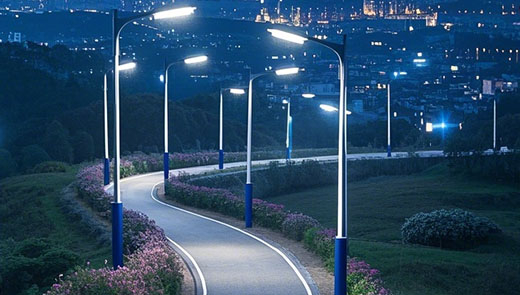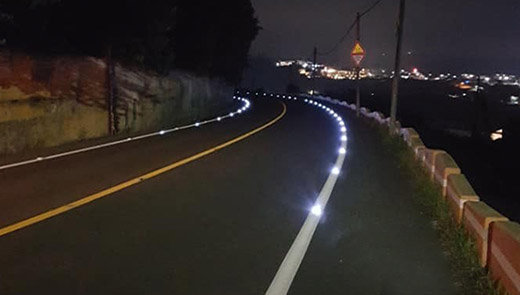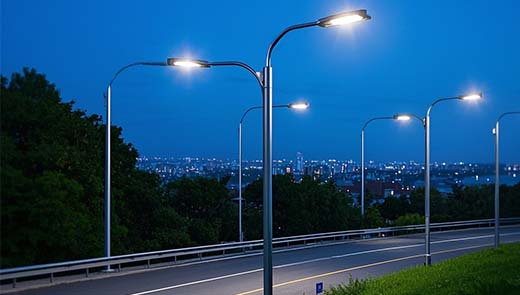How Long Is the Lifespan of Solar Road Studs?
Feb 21, 2025
In the protection of road traffic safety in the many facilities, solar road studs play an important role. It is not only at night or under adverse weather conditions for drivers to provide clear road guidance, but also by virtue of its environmentally friendly and energy-saving features, become the ideal choice for modern road construction. However, many people have a question in mind: how long is the life of solar road studs? This issue is not only related to road maintenance costs but also directly affects the safety of the road. Next, we will explore the life of solar road stud-related issues.
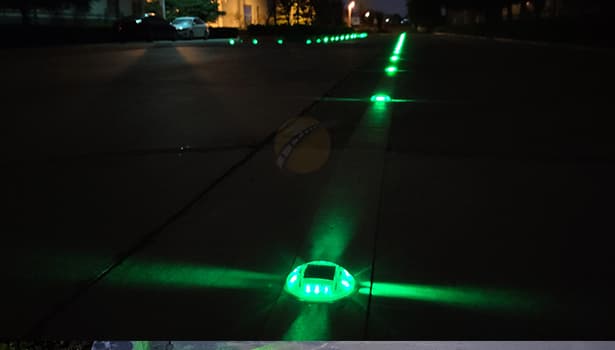
Road studs are rich and diverse types, each with its unique uses and advantages.
and other types of road studs compared to the advantages of solar road studs are very significant. It does not need an external power supply, completely relying on solar power, which not only saves the cost of laying wires and energy but also reduces the dependence on traditional energy sources. Moreover, its automatic light-emitting properties in the dim light environment can provide more stable, more obvious road guidance and effectively improve the safety of night driving.
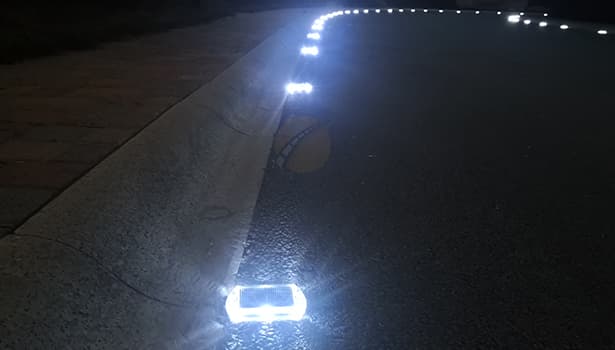
Solar road studs are mainly composed of solar panels, LED chips, and batteries. Solar panels are located on the top of the stud and are responsible for collecting solar energy; LED chips are distributed on both sides of the stud, facing the direction of vehicular traffic, and are used to send out eye-catching light; and the battery is responsible for storing the responsibility of electricity.
During the daytime, the solar panel fully receives sunlight, converts solar energy into electric energy, and stores the electric energy in the battery through the internal circuit. When the night falls or the light becomes weak, the built-in photoelectric switch of the solar road studs will be automatically activated, and the battery will release the stored electricity to supply power to the LED chip so that it will emit bright light, thus clearly outlining the outline of the road and guiding the direction for the driver. Usually, solar road studs are mainly installed at two key locations, the centerline and the edge of the road, to play their role of road marking. To withstand heavy vehicles, they need to be embedded in the road surface, and their tops need to be 5 mm to 8 mm above the road surface, and when installed correctly, solar road studs have a lifespan of 7 to 9 years and require low maintenance. In addition, properly placed solar-powered LED road studs are highly reflective and provide drivers with a reaction time of about 25 to 30 seconds to maneuver their vehicles on time.
Under normal conditions of use and maintenance, the life expectancy of solar pegs is generally 7 - 9 years. However, the actual life expectancy may vary depending on the factors mentioned above. For example, in the case of good environmental conditions, proper maintenance, and good quality components, the solar stud may be used for more than 9 years; on the contrary, if it is subjected to a harsh environment for a long time and lacks the necessary maintenance, its life span may be shortened to 5 years or even shorter. Some actual cases show that in the dry and sunny areas in the north, reasonable maintenance of the solar stud can work stably for more than 8 years; and in the south of the humid and acid rain in coastal areas, if the stud's protective properties are not enough, its life expectancy may be greatly affected.
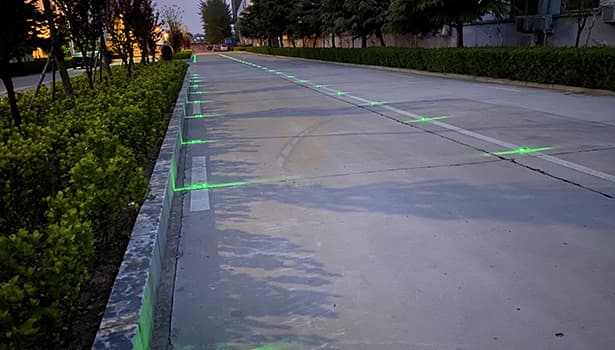
The durability of the solar stud depends largely on the quality of its components. High-quality solar panels, batteries, LED lights, and controllers are the basis for extending the life of the stud. High-quality solar panels with high conversion efficiency can more effectively convert solar energy into electricity; high-quality batteries provide stable energy storage, charging, and discharging more times; high-performance LED lights are stable and long-lived; and an accurate controller can ensure the stable operation of the entire system. Therefore, when choosing solar studs, it is important to pay attention to the quality of their components and choose products equipped with high-grade materials and components.
The battery plays a crucial role in solar studs, which are responsible for storing the solar energy collected during the day for use at night. The type and capacity of the battery directly affect the service life of the stud. Compared with traditional lead-acid batteries, lithium-ion batteries have the advantages of long life and stable performance. Lithium-ion batteries have a higher energy density and can store more power in a smaller volume, and they have a higher number of charge/discharge cycles and can withstand long-term use. Therefore, solar road studs with lithium-ion batteries tend to have a longer service life.
A solar panel is the core component of converting solar energy into electricity. Efficient solar panels can not only charge quickly in full sunlight but also in the case of poor lighting conditions to maintain a certain power generation efficiency. At the same time, high-quality solar panels with good weather resistance can withstand harsh weather conditions, such as high temperature, low temperature, strong winds, rainstorms, etc., in the process of many years of use to always maintain the best performance, thus ensuring the long-term stable operation of the solar road studs.
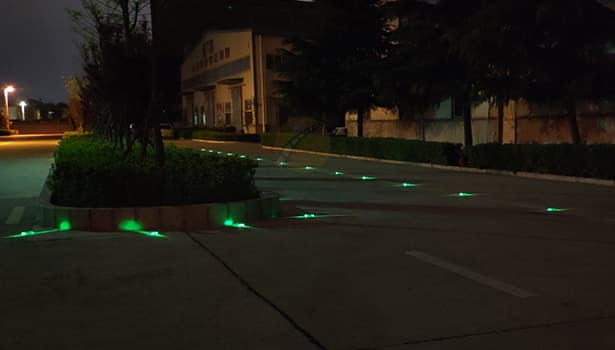
The working environment in which the solar stud has a great impact on its life. Extreme temperatures, high humidity, a lot of dust, and corrosive atmospheric conditions, etc., may damage the performance and life of the stud. For example, in a high-temperature environment, the performance of the battery will be reduced, and even bulging, leakage, and other problems may occur; in a humid environment, the electronic components are prone to moisture short-circuit; and in the dusty or corrosive gases in the area, the solar panels and the stud shells may be eroded, affecting their normal work. Therefore, it is crucial to choose solar road studs with good protective performance and the ability to adapt to different environments.
Regular maintenance and upkeep of solar studs is the key to prolonging their service life. This includes regular cleaning of the solar panels to ensure that their surfaces are free of dust and stains to improve the efficiency of solar energy absorption; checking individual components for signs of wear and tear and aging to detect and deal with potential problems on time; and ensuring the normal operation of the entire system, such as checking whether the circuit connections are loose and whether the photoelectric switches are sensitive. Once the battery or other components are found to be faulty, they should be replaced promptly to avoid early damage to the stud due to minor problems.
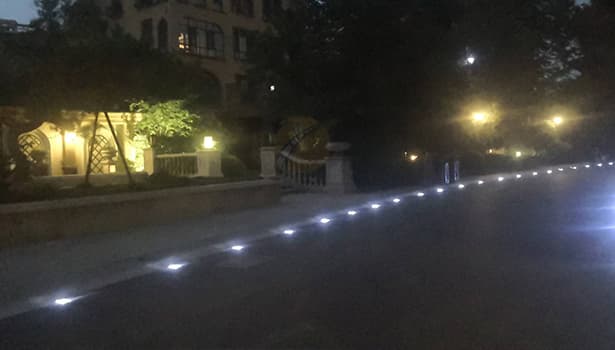
When only a few solar studs show signs of wear and tear, you can choose to replace them individually. This approach can both minimize the impact on traffic and save costs. First, carefully inspect the roadway to identify those studs that are no longer functioning properly. Common signs of damage include dimmed lights, inability to charge, or cracks in the structure of the stud. Once you've identified the damaged studs, you can begin replacing them:
If a large number of solar studs are damaged, it may be more efficient to perform a total system replacement. Over time, factors such as weather erosion, wear and tear, and traffic stress can cause the performance of the entire stud system to deteriorate. A total replacement will ensure that the roadway remains in good safety condition for many years to come. The steps are as follows:
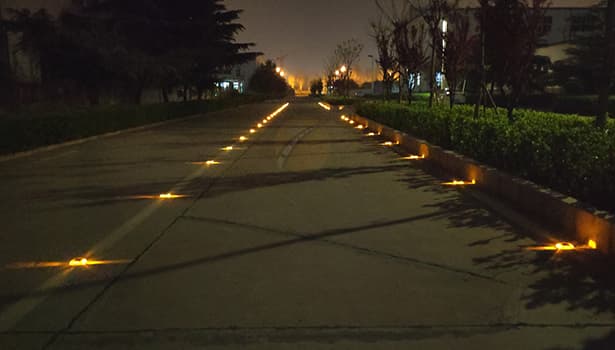
The lifespan of solar road studs is affected by a combination of factors, including component quality, cell performance, solar panel efficiency, environmental conditions, and maintenance practices. Understanding these factors helps us to take the right approach when selecting, installing, and using solar road studs to extend their service life and reduce road maintenance costs. At the same time, mastering the method of replacing solar road studs at the end of their service life can ensure that the road is always in good and safe condition, providing reliable road guidance for drivers. Whether individual replacement or overall system replacement, it is necessary to follow a scientific process to ensure the normal operation of the new road stud. In future road construction and maintenance, the rational use and maintenance of solar road studs will make a positive contribution to road traffic safety and environmental protection.

What is a solar road stud?
1. Common types of road studs
Road studs are rich and diverse types, each with its unique uses and advantages.
- ceramic stud: as a traditional stud, it consists of a ceramic or glass shell wrapped with reflective material inside. At night, it can reflect the light from car headlights so that drivers can see clearly from a certain distance away. However, compared to some of the new studs, its durability is slightly less.
- Plastic Road Stud: It is widely used on roads due to its durability and lower cost. It is made of high-quality plastic with good reflective properties, easy to install, and easier to maintain later.
- Solar stud: This is a very innovative and environmentally friendly stud. It cleverly combines solar panels and LED lights, absorbing solar energy during the day and storing it, and then automatically emitting light at night to illuminate the road. The energy utilization of this stud is efficient and environmentally friendly, greatly reducing the impact of road lighting on the environment.
- Aluminum Road Stud: Strong texture, long service life, commonly used in areas with high traffic flow. Its good reflective properties can ensure that, in a variety of road conditions, drivers provide clear road signs.
2. Advantages of solar road studs
and other types of road studs compared to the advantages of solar road studs are very significant. It does not need an external power supply, completely relying on solar power, which not only saves the cost of laying wires and energy but also reduces the dependence on traditional energy sources. Moreover, its automatic light-emitting properties in the dim light environment can provide more stable, more obvious road guidance and effectively improve the safety of night driving.

How do solar LED road studs work?
1.components of solar road studs
Solar road studs are mainly composed of solar panels, LED chips, and batteries. Solar panels are located on the top of the stud and are responsible for collecting solar energy; LED chips are distributed on both sides of the stud, facing the direction of vehicular traffic, and are used to send out eye-catching light; and the battery is responsible for storing the responsibility of electricity.
2.Workflow of solar road reflectors
During the daytime, the solar panel fully receives sunlight, converts solar energy into electric energy, and stores the electric energy in the battery through the internal circuit. When the night falls or the light becomes weak, the built-in photoelectric switch of the solar road studs will be automatically activated, and the battery will release the stored electricity to supply power to the LED chip so that it will emit bright light, thus clearly outlining the outline of the road and guiding the direction for the driver. Usually, solar road studs are mainly installed at two key locations, the centerline and the edge of the road, to play their role of road marking. To withstand heavy vehicles, they need to be embedded in the road surface, and their tops need to be 5 mm to 8 mm above the road surface, and when installed correctly, solar road studs have a lifespan of 7 to 9 years and require low maintenance. In addition, properly placed solar-powered LED road studs are highly reflective and provide drivers with a reaction time of about 25 to 30 seconds to maneuver their vehicles on time.
Life Expectancy of Solar Road Studs
Under normal conditions of use and maintenance, the life expectancy of solar pegs is generally 7 - 9 years. However, the actual life expectancy may vary depending on the factors mentioned above. For example, in the case of good environmental conditions, proper maintenance, and good quality components, the solar stud may be used for more than 9 years; on the contrary, if it is subjected to a harsh environment for a long time and lacks the necessary maintenance, its life span may be shortened to 5 years or even shorter. Some actual cases show that in the dry and sunny areas in the north, reasonable maintenance of the solar stud can work stably for more than 8 years; and in the south of the humid and acid rain in coastal areas, if the stud's protective properties are not enough, its life expectancy may be greatly affected.

Key factors affecting the life of the solar stud
1. The quality of the components
The durability of the solar stud depends largely on the quality of its components. High-quality solar panels, batteries, LED lights, and controllers are the basis for extending the life of the stud. High-quality solar panels with high conversion efficiency can more effectively convert solar energy into electricity; high-quality batteries provide stable energy storage, charging, and discharging more times; high-performance LED lights are stable and long-lived; and an accurate controller can ensure the stable operation of the entire system. Therefore, when choosing solar studs, it is important to pay attention to the quality of their components and choose products equipped with high-grade materials and components.
2. Battery performance
The battery plays a crucial role in solar studs, which are responsible for storing the solar energy collected during the day for use at night. The type and capacity of the battery directly affect the service life of the stud. Compared with traditional lead-acid batteries, lithium-ion batteries have the advantages of long life and stable performance. Lithium-ion batteries have a higher energy density and can store more power in a smaller volume, and they have a higher number of charge/discharge cycles and can withstand long-term use. Therefore, solar road studs with lithium-ion batteries tend to have a longer service life.
3. Solar panel efficiency
A solar panel is the core component of converting solar energy into electricity. Efficient solar panels can not only charge quickly in full sunlight but also in the case of poor lighting conditions to maintain a certain power generation efficiency. At the same time, high-quality solar panels with good weather resistance can withstand harsh weather conditions, such as high temperature, low temperature, strong winds, rainstorms, etc., in the process of many years of use to always maintain the best performance, thus ensuring the long-term stable operation of the solar road studs.

4. Environmental conditions
The working environment in which the solar stud has a great impact on its life. Extreme temperatures, high humidity, a lot of dust, and corrosive atmospheric conditions, etc., may damage the performance and life of the stud. For example, in a high-temperature environment, the performance of the battery will be reduced, and even bulging, leakage, and other problems may occur; in a humid environment, the electronic components are prone to moisture short-circuit; and in the dusty or corrosive gases in the area, the solar panels and the stud shells may be eroded, affecting their normal work. Therefore, it is crucial to choose solar road studs with good protective performance and the ability to adapt to different environments.
5. Maintenance measures
Regular maintenance and upkeep of solar studs is the key to prolonging their service life. This includes regular cleaning of the solar panels to ensure that their surfaces are free of dust and stains to improve the efficiency of solar energy absorption; checking individual components for signs of wear and tear and aging to detect and deal with potential problems on time; and ensuring the normal operation of the entire system, such as checking whether the circuit connections are loose and whether the photoelectric switches are sensitive. Once the battery or other components are found to be faulty, they should be replaced promptly to avoid early damage to the stud due to minor problems.

How to Replace Solar Road Studs After Their Lifespan?
1. The replacement of individual damage to the stud
When only a few solar studs show signs of wear and tear, you can choose to replace them individually. This approach can both minimize the impact on traffic and save costs. First, carefully inspect the roadway to identify those studs that are no longer functioning properly. Common signs of damage include dimmed lights, inability to charge, or cracks in the structure of the stud. Once you've identified the damaged studs, you can begin replacing them:
- Remove studs: Using a pry bar or similar tool, carefully pry out the damaged studs. Always make sure there is no residue left on the pavement from the old stud that could interfere with the installation of the new stud.
- Clean the mounting holes: After removing the studs, clean the mounting holes of debris, dust, and glue residue to provide a clean, level base for the installation of the new studs.
- Apply new glue: Choose a high-quality epoxy resin or road glue specifically designed for outdoor use, which can hold the new stud securely even under the weight of heavy vehicles.
- Install the new studs: Place the new solar studs into the mounting holes and press firmly to secure them in place. Ensure that the stud remains flush with the road surface to avoid protruding or sinking, which may affect the use of the effect and safety.
- Wait for the adhesive to cure: Allow the adhesive to fully dry and cure before reopening the road to traffic. This step ensures that the new road studs are installed securely to avoid loosening or falling off during vehicle travel.
2. Total System Replacement
If a large number of solar studs are damaged, it may be more efficient to perform a total system replacement. Over time, factors such as weather erosion, wear and tear, and traffic stress can cause the performance of the entire stud system to deteriorate. A total replacement will ensure that the roadway remains in good safety condition for many years to come. The steps are as follows:
- Assess the road condition: Before replacement, a thorough inspection of the road and its infrastructure is carried out. If a large number of studs are failing, it may indicate an underlying road problem, such as poor pavement condition or excessive wear. Fixing these problems before replacing the studs will ensure the long-term stability of the new studs.
- Remove all old studs: Using specialized machines or tools, remove all old solar studs from the roadway and clean the entire roadway in preparation for the installation of new studs.
- Clean and prepare the road surface: After removing the old studs, thoroughly clean the road surface and remove debris, dust, and residual glue to ensure that the road surface is clean and tidy.
- Installation of new studs: Follow the installation process for individual replacement studs, but since this is a large-scale replacement, more personnel can be scheduled to work at the same time to speed up the installation process.
- System calibration and testing: After the installation is completed, all new road studs are inspected and tested. Ensure that they are properly charged and illuminated, and that the brightness and flashing frequency of the lights are in accordance with traffic rules and actual usage requirements, and are consistent with traffic flow and visibility requirements.

Conclusion
The lifespan of solar road studs is affected by a combination of factors, including component quality, cell performance, solar panel efficiency, environmental conditions, and maintenance practices. Understanding these factors helps us to take the right approach when selecting, installing, and using solar road studs to extend their service life and reduce road maintenance costs. At the same time, mastering the method of replacing solar road studs at the end of their service life can ensure that the road is always in good and safe condition, providing reliable road guidance for drivers. Whether individual replacement or overall system replacement, it is necessary to follow a scientific process to ensure the normal operation of the new road stud. In future road construction and maintenance, the rational use and maintenance of solar road studs will make a positive contribution to road traffic safety and environmental protection.

